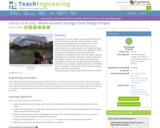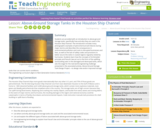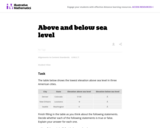
The text of the Reconstruction Acts of 1867. Section one establishes military districts in the South.
- Subject:
- Social Studies
- Material Type:
- Primary Source
- Provider:
- Texas State Library and Archives Commission
- Date Added:
- 08/07/2023

The text of the Reconstruction Acts of 1867. Section one establishes military districts in the South.

A short video explaining the seasons and how nature changes within the year. Video also discusses how we change to adapt to the different seasons. [3:00]

At this point in the unit, students have learned about Pascal's law, Archimedes' principle, Bernoulli's principle, and why above-ground storage tanks are of major concern in the Houston Ship Channel and other coastal areas. In this culminating activity, student groups act as engineering design teams to derive equations to determine the stability of specific above-ground storage tank scenarios with given tank specifications and liquid contents. With their floatation analyses completed and the stability determined, students analyze the tank stability in specific storm conditions. Then, teams are challenged to come up with improved storage tank designs to make them less vulnerable to uplift, displacement and buckling in storm conditions. Teams present their analyses and design ideas in short class presentations.

Students are provided with an introduction to above-ground storage tanks, specifically how and why they are used in the Houston Ship Channel. The introduction includes many photographic examples of petrochemical tank failures during major storms and describes the consequences in environmental pollution and costs to disrupted businesses and lives, as well as the lack of safety codes and provisions to better secure the tanks in coastal regions regularly visited by hurricanes. Students learn how the concepts of Archimedes' principle and Pascal's law act out in the form of the uplifting and buckling seen in the damaged and destroyed tanks, which sets the stage for the real-world engineering challenge presented in the associated activity to design new and/or improved storage tanks that can survive storm conditions.

The purpose of this task is to help students interpret signed numbers in a context as a magnitude and a direction and to make sense of the absolute value of a signed number as its magnitude.

This video segment adapted from First Light explains why the highest peak in the Pacific, Mauna Kea, is an ideal site for astronomical observations. Featured are new telescope technologies that allow astronomers to explore the universe in more depth.

This video segment adapted from First Light explains why the highest peak in the Pacific, Mauna Kea, is an ideal site for astronomical observations. Featured are new telescope technologies that allow astronomers to explore the universe in more detail. [5:39]

Above the Noise host Shirin Ghaffary weighs the potential health risks of drinking energy drinks and compares them to other sugary, caffeinated beverages. Energy drinks are a billion-dollar industry and their popularity keeps growing despite health concerns. We are warned they are particularly dangerous for children and teens -- and there have even been reports of deaths linked to energy drink consumption. In this video we take a closer look at the science to see if energy drinks are really as bad as the hype, and what it is about them that has doctors concerned. A student handout is provided. [4:06]

Performative activism is usually defined as activism done to make yourself look good rather than because you're committed to a cause. But is performative activism always bad? True, it turns the spotlight on yourself, not the issue. On the other hand, jumping on a hashtag bandwagon could help raise awareness and lead to activism IRL. Watch the video, weigh the evidence and let us know: Can performative activism make a difference? A lesson plan is included. [7:52]

Virtual reality is gaining traction as a powerful technology for education. Scientists say virtual reality can even promote empathy -- the ability to put yourself in somebody else's shoes. But can VR make you a better person? Watch the latest Above the Noise episode to find out. A student handout is included. [5:29]

In Above the Noise, a YouTube series for teens, host Myles Bess takes viewers along on his journey to cut through the hype and dive deep into the research behind the issues affecting their daily lives. Every other week, the series investigates controversial subject matter to help young viewers draw informed conclusions, while inspiring media literacy and civic engagement. Lesson plans and other material provide support for bringing Above the Noise into the classroom. Students can join topic discussions on KQED Learn. In This Collection: Video (185), Media Gallery (2), Image (2), Webpage (1) for Grades 6-8, 9-12

Deciding on attending college is a big decision. What college should I attend? Can I afford college? Can I succeed without college? Use this collection to help inform your decision on whether college is the right path.

This whole coronavirus thing is messing up every aspect of society. School is no exception, with millions of students now stuck at home dealing with a bunch of new stress. How do you deal with so much uncertainty in the time of coronavirus? Included is a lesson plan to accompany the video. [6:23]

It's not hard to find a high school student who is stressed about homework. Many are stressed to the max - juggling extracurricular activities, jobs, and family responsibilities. It can be hard for many students, particularly low-income students, to find the time to dedicate to homework. So students in the PBS NewsHour Student Reporting Labs program at YouthBeat in Oakland, California are asking what's a fair amount of homework for high school students? Included is a lesson plan to accompany the video. [6:40]

In the earlier days of the coronavirus pandemic, there was a lot more confusion about whether people should wear masks to protect themselves and others from the virus. Here's why recommendations have changed-even for kids and teens and how they help keep COVID-19 in check. Included is a lesson plan and student viewing guide. [9:00]

The debate over the best way to teach sex ed in America continues to rage on, but student voice is often left out of the conversation when schools are deciding on what to teach. So Myles and PBS NewsHour Student Reporters from Oakland Military Institute investigate the pros and cons of the various approaches to sex ed and talk to students to find out how they feel about their sexual health education. Included is a lesson plan and student viewing guide. [9:15]

Student homelessness in the US is a tricky thing to quantify. HUD -- the federal government's Department of Housing and Urban Development -- controls most of the money used to help the homeless. But, that agency misses about 4 in 5 homeless students. Why? It's all about how you define the term "homeless". According to HUD, you're only considered homeless if you're living in a shelter or living on the streets. But according to the Department of Education, about 80% of the 1.3 million homeless students living in the US are couch surfing, living in motels, or doubling up with family or friends. These students aren't eligible for HUD money, so increasingly, it's up to schools to provide help. Host Myles Bess explores how homeless students get the help they need when different federal agencies use competing definitions to define who's homeless. A student handout to accompany the video is included. [5:54]

No doubt about it: the pandemic has taken a toll on students' mental health, especially those dealing with family members getting sick or losing jobs. And distance learning just adds to the struggle. It's hard to stay focused and connected through a screen. At the same time, could there be some hidden benefits, such as the ability to work at your own pace (and in PJs) and avoid the anxiety-inducing drama of school IRL? What do you think? Are there any upsides to distance learning? A student handout to accompany the video is included. [7:34]

The World Health Organization is worried about video games-just recently, it officially recognized "Gaming Disorder" as a mental health condition. But it's not that simple. The American Psychiatric Association isn't convinced and says there's not enough research showing that video game addiction is its disorder. So what's going on? Is video game addiction REALLY a thing? Find out in the latest Above the Noise episode. An activity to accompany the video is included. [6:09]

By 2050, the World Economic Forum predicts that the amount of plastic in the oceans will outweigh ALL the fish. When you hear "plastic" pollution, you might picture six-pack rings wrapped around seagulls or beaches littered with plastic bottles. But now, researchers are discovering a new menace -- microfibers. They're tiny strands of synthetic fibers that come from the synthetic clothing that many of us love to wear -- think fleece jackets and yoga pants. Find out what we can do about microfiber pollution in this weeks Above the Noise video. A student handout to accompany the video is included. [6:04]